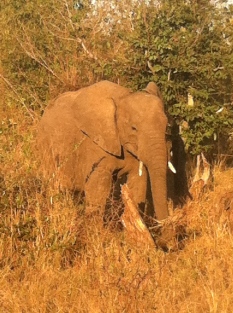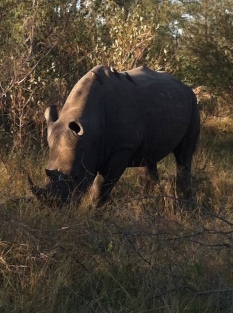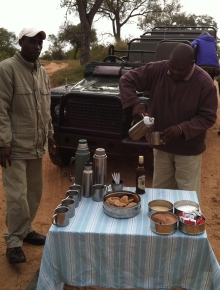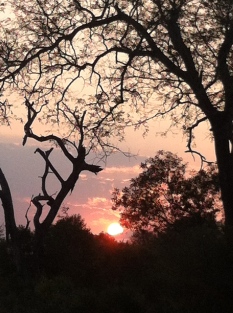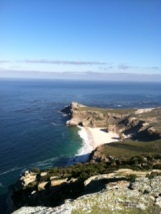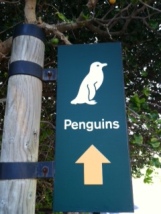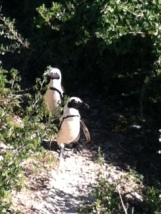On Safari
In Hemingway’s “The Short Happy Life of Francis Macomber,” the guide, Wilson, carries with him a doublewide cot for “windfalls,” the odd wife that would like to bed him—as Mrs. Macomber does. According to Paul Theroux in Dark Star Safari: Overland from Cairo to Cape Town (2003), the tracker-guides often feel stalked themselves by female guests, some pursuing them for a one night stand while others are so besotted with the bush that they dream of living out their lives on constant safari.
Theroux gets it right about the new luxury safaris that are about taking photographs rather than trophies. Tourists are after the Big Five—elephants, rhino, water buffalo, lions, and leopards—for the perfect shot, that is the perfect picture. Photographers compete to see who has the longest lens, the fastest rapid snaps. This is all done from the relative comfort of sturdy Land Rovers that seat about six people in tiered seats with the ranger guide driving and the tracker perched precariously at the front of the vehicle in a specially outfitted chair. The forward seat not only allows spotting of animals and birds but also gives a better vantage point to instruct the driver on avoiding stumps that could cripple a vehicle when they’ve gone off track and into the bush to chase a trio of wild dogs. I can say that with certainly as that’s exactly what we did, thorny branches brushing perilously close to the clients, something like Mr. Toad’s wild ride. In fact, I’d recommend that the must pack list for safaris include not only the requisite sunglasses but also clear safety glasses for dusk or dawn driving when the wind can burn or those thorns seem intimidating.
Our prep list for safari included recommended gratuities for the various staff. I estimated that we’d need about 4000 rand for our eight days on safari, but my husband said that was too much as there could not possibly be a butler as listed among the staff. But when we flew in by small plane to the airstrip near Kirkman’s Camp and were greeted by the receptionist, we were also introduced to our butler. Theroux points out, “Hemingway’s gun bearers had morphed into Jeeves-like butler and game spotters.” Dark Star Safari’s last several chapters are particularly relevant to our travels. The history of the camp where we are lodged is addressed in his chapter on Mala Mala, a private game reserve whose owner figured a better economy was based on tourists rather than hunters. He purchased the former cattle ranch that became Kirkman’s Kamp, the old farmhouse turned into a comfortable lodge area with Paul’s Pub being the center of attention at the end of the day as guides tally their day’s sightings of animals and birds on the chalk board lists. Guests are housed in comfortable cottages that look over the Sand River and are free to roam to the boundaries of the Camp—but not beyond—during the day, and at night, security guards escort guests even the short distance between room and dinner. With good cause. A hippo grazed on the lawn on two evenings—the animal most likely to inflict casualties. The Vervet monkeys with their signature blue balls were merely nuisances, trying to steal food when a guest’s back is turned. On the other hand, on our last night at camp, we arrived from the dusk game drive to find a hyena on the lawn, the sneaky critter having gone into the lodge and stolen bar food—although passing up on the Tom Collins.
Theroux describes a typical day’s agenda in a luxury safari camp, and it is about the same as our experience:
- 5:30 am wake up knock by the guide
- coffee and tea at the lodge
- 6:00 am departure on game drive before the sun is up
- About three hours on the actual drive with a “coffee break” near the end—featuring Amarula liqueur in the hot chocolate or coffee
- Return to camp at 9 am for breakfast—a buffet plus hot meals to order (on one morning, two Land Rover groups are treated to breakfast in the bush, a cook out with all the trimmings)
- Rest of a nature walk with a guide
- 1:00 lunch with a chalk board outlining a three-course menu: corn coconut soup; coriander fish cakes or chickpea burger; classic Caesar salad, roasted beet salad; honey-cinnamon roasted nectarines with homemade ice cream
- Rest, swim in the infinity pool, have a massage, stroll the grounds looking at the Vervet monkeys, watching a herd of elephants saunter along on the river bank opposite.
- High tea before the game drive.
- 3:00 pm game drive with a cocktail stop—with the guides bringing out a collapsible table, complete with linen tablecloth, and a selection of drinks, including the classic gin & tonic.
- 6:00 return to lodge for the gathering in the pub to compare notes
- 7:00 pm dinner, which is with your Land Rover group every other night and may include singing and dancing by locals plus staff. For those traveling solo, a staff member is always on hand so no one has to dine alone.
- More swapping of tales post-dinner but generally early to bed.
And what do guests see? As with Theroux’s safari, we saw water buffalo with the Ox Picker atop them in a mutually beneficial relationship as the birds plucked off insects that were knocked off trees when the animals went under branches. Naturally, the Big Five are desirable, but the giraffes browsing on trees, the herd of zebra, the striped Kudhu, the funky warthog also bring a thrill to the viewers. Our guide, a PhD in Poo, a Doctor of Dung-ology, was able to locate many of our sightings through reading scat or tracks.
In the down time between activities, guests may indulge in reading, and Theroux receives recommendations from Nadine Gordimer and her friends when he visits her in Johannesburg.
- Govan Mbeki, The Peasants’ Revolt
- Huge Lewin, Bandiet
- Zakes Mda, Ways of Dying
- Albie Sachs, The Soft Vengeance of a Freedom Fighter
Theroux carries with him, though, for emergency readings Montaigne’s Essays, a good recommendation that a traveler should always pack prepared with at least one back-up reading that doesn’t rely on e-format.
And speaking of recommendations, I don’t think I can recommend James McClure’s detective series featuring Kramer and Zondi. Published in the 1970s, the narratives feature racist and derogatory language, perhaps meant to appall, but nevertheless disturbing. The Gooseberry Fool, in spite of my real like of this fruit, actually refers to a chaperone. I had hoped for an escapist read, but this one allowed no easy gratification. The primary benefit was a listing of other books in country-based series at the back of the volume. Much better to pick up Theroux’s wonderful account of his travels from the top to the bottom of an intriguing continent.

